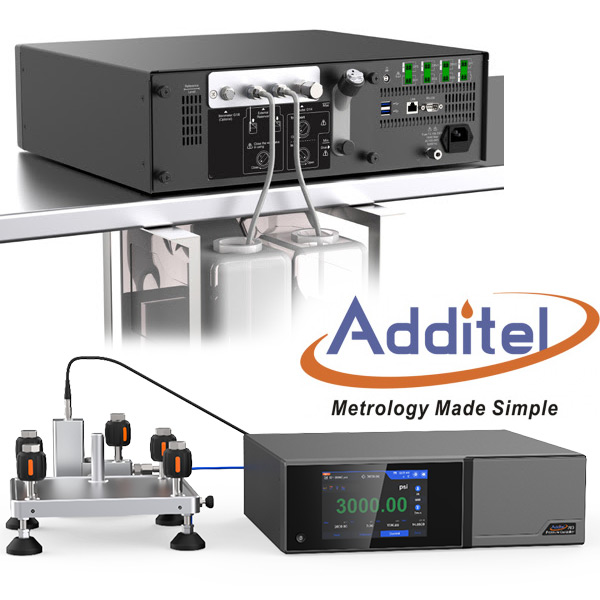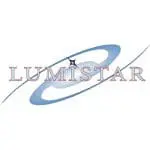 Building off of the proven success of the LS-28-DRSM, Lumistar has designed a complementary product that when mated with the DRSM allows for a suite of new capabilities in a very small envelope.
Building off of the proven success of the LS-28-DRSM, Lumistar has designed a complementary product that when mated with the DRSM allows for a suite of new capabilities in a very small envelope.
AerospaceTestingInternational.com
Modular Range Re-Transmission and Data Integrity Checkout System
An upconverter that can be mated with existing telemetry processing stations offers extended functionality for range flight test operations
// MARK McWHORTER
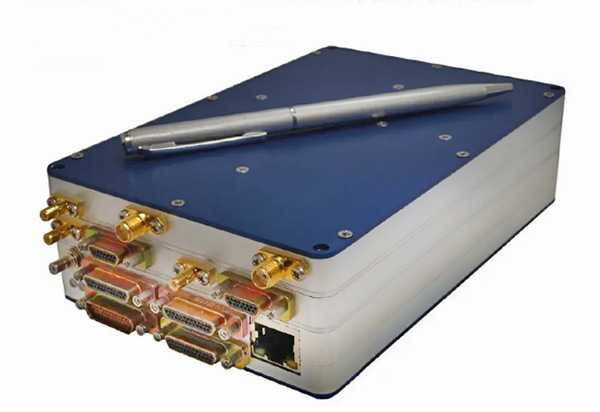
Visualizing pictures of a beautifully styled VIP aircraft with bathrooms, wooden furniture in the dining area and luxurious lamps providing a warm and natural atmosphere makes one wonder how it can all be realized. What has to be done to get these parts designed, produced and finally qualified to international aerospace requirements? Or what does it take to get an air-to-air missile fully qualified for combat?
Although not immediately apparent, advanced telemetry systems are an integral part of the development process for both comfortable air passenger environments and precision munitions. Without the innovative products and expertise deployed for flight testing from the international telemetry community, such aeronautical achievements would not be realized.
Building off of the proven success of the LS-28-DRSM, Lumistar has designed a complementary product that when mated with the DRSM allows for a suite of new capabilities in a very small envelope.
The new LS-76-M2 Series upconverter is a standalone dual-channel IF (intermediate frequency) to RF (radio frequency) tunable upconverter module with multipath simulation capabilities. The LS-76-M2 will accept a single IF signal at 10-200MHz and upconvert to any tunable frequency from 200MHz to 7GHz. When the LS-76-M2 is mated to the LS-28-DRSM the resultant LS-96-M2 system creates new applications using the receiving, modulation, upconversion, and data quality measurement capabilities.
Modular Data Re-Transmission System Application
Many of Lumistar’s range customers have consistent problems receiving good bits from RF datalinks that are not line-of-sight at various times in a typical ConOps range flight test. One typical example is when the target airframe is at preflight check and typically obscured from the distant main receiving station or stations by hangars, buildings or trees (Figure 2).
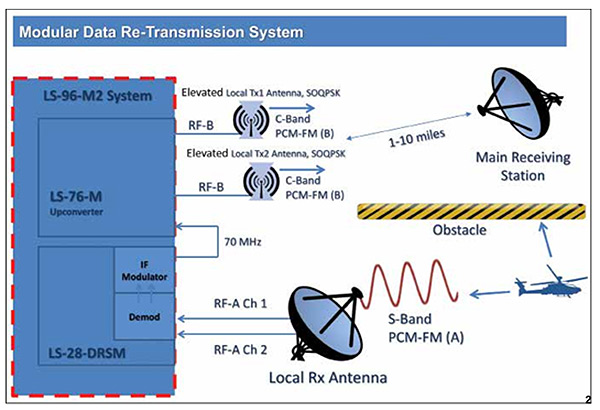
The LS-96-M2 can be placed locally on the flight line and will receive the preflight telemetry, and process it down to clock/ data outputs. These clock and data signals are fed to the LS-28-DRSM’s onboard dynamic IF modulator, where the data can be modulated to one of many formats. The modulated output, necessarily at the same data rate, is then fed to the input of the upconverter module of the LS-96-M2, where it is first split into two streams and then unconverted to RF. The LS-96-M2 allows for upconversion from 200MHz to 7GHz at a power output of up to +20dBm. The output from each unconverted channel can be fed to a typical high-gain directional transmit antenna that is placed at an elevated location at the local site, and pointed directly to the range receiving infrastructure site.
Conversely, a directional receive antenna that can be identical to the transmit antenna can be placed at the receiving station, and the RF brought into the system at the distant site for demodulation and data processing.
Modular Loopback Range Telemetry Check-Out System
A second application for the LS-96-M2 system is a complete modular loopback range telemetry check-out system. In this application (Figure 3), the identical LS-96-M2 unit is configured differently than as shown in Figure 2. The internal IF modulator feature inside the LS-28-DRSM can generate a test pattern signal, typically at 70MHz, which can be configured to provide data rates up to 40Mbps from internally derived data patterns.
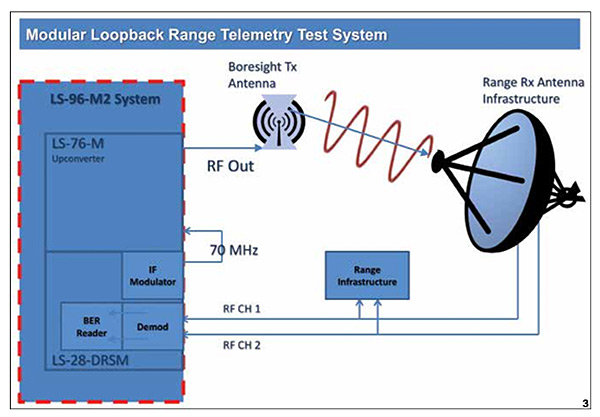
The test pattern signal can be PRN, frame simulation, user-defined or external derived data. The data can be modulated with any appropriate format.
Once modulated, the 70MHz is cabled over to the LS-76-M2 modular upconverter and translated up to any RF frequency between 200MHz and 7GHz. The RF can then be fed to a boresight antenna at power level up to 20dBm without the need for external amplification.
This antenna can be situated in such a way as to return the RF back to the main range infrastructure receiving antenna(s). The received RF signal is routed back to the dual RF inputs of the LS-28-DRSM, or to any range telemetry receiving asset, then demodulated and bit errors collected.
The modulator section in the LS-28DRSM can be configured to provide Doppler simulation and injected white noise. Therefore, the range telemetry check-out system is able to create RF profiles that could be expected to be encountered in real-world scenarios.
Multipath Simulation
In addition to Doppler and additive white noise, the system also employs a multipath simulation capability. Each unconverted RF signal can be dynamically attenuated at the RF frequency of propagation. Known multipath profiles, such as standard waveforms, previously recorded multipath profiles, or user programmable multipath, can be generated. The multipath depth is greater than 90dB, and the fade rate is greater than 20kHz.
Modular Telemetry
Lumistar’s LS-28-DRSM Modular RF/Digital Telemetry System can stand alone as a fully integrated telemetry processing station or can mate with other Lumistar products to meet extended requirements.
The modular unit supports up to six bands of dual channel RF signals, multiple digital demodulation formats, bit and frame synchronization, diversity combining, three stream data recording, decommutation, IRIG and network time synchronization and Ethernet UDP data broadcasting. Software displays include Spectrum, O-scope and Constellation patterns. Hardware and firmware options support many uses.
The modular unit supports many error correction schemes, such as Viterbi, Reed-Solomon, LDPC, STC, Best Source Selection, and Adaptive Equalization. An added feature is the modular unit’s versatile IF Modulator, which can produce many data waveforms used in typical system test scenarios, including Doppler and Multipath simulation.
Other features include spectrum sensing, data re-transmission, and digital communication system data link analysis.
All of these capabilities are included in a small modular unit under 41in3 (670cm3) 2 lb (0.9kg) and consuming just 45W at 10-40V DC.
Beyond the excellent RF performance, at the heart of the modular design is a flexible and extensible multicore DSP engine that can assume any one of 12 “personalities”. The unit is constructed via four hardware slices: RF, IF, DSP and control processing.
Adding to the unit’s design flexibility, it can be constructed using only two or three slices when requirements demand different hardware configurations without RF capabilities. Owing to the open-ended firmware-based architecture of the LS-28DRSM series products, many more personality-based applications are conceivable and achievable.
LS-76-M2 Upconverter Design and Capabilities
The LS-76-M2 upconverter used in the LS-96-M2 modular range re-transmission and data integrity check-out system uses advanced design and technology. The unit is capable of withstanding harsh environments, including resistance to vibration and shock. It is ideally suited for applications where size, weight and power are key design considerations.
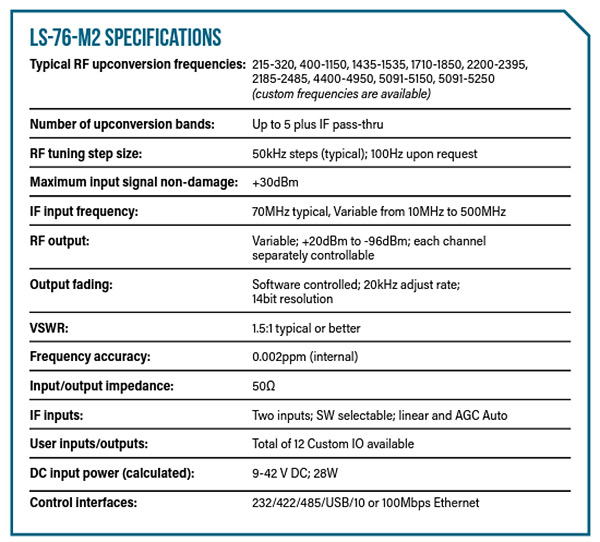
The unit provides standard RF upconversion bands of 215-320, 400-1150, 1435-1535, 1710-1850, 2200-2395, 2185-2485, 4400-4950, 5091-5150, and 5091-5250MHz, plus an IF band pass-thru. RF tuning resolution is typically 50kHz, however tuning steps as small as 50Hz are possible. The maximum IF input signal is 1W. The IF input frequency, which typically will be in the 70MHz range, can be varied from as low as 10MHz to 500MHz. If a specific IF input frequency is required, Lumistar can be consulted for details. The unit boasts a powerful RF output at 20dBm, which is more than sufficient power to provide re-transmission over several miles using directional antennas. Lumistar is able to provide specific ‘Link Analysis Support’ if it is needed to ensure your line-of-sight communications link.
Each channel has separately controllable attenuation over a >90dB range, thus providing independent multipath attenuation simulation characteristics for dual-polarity systems. The upconverter provides this fading via software control, up to a 20kHz rate, 14bit resolution, using analog variable attenuation. Thus no break in the data stream occurs during fading events. The frequency accuracy is better than 0.002ppm. The upconverter operates from a DC power supply 9-42V DC and consumes around 26W.
The LS-76-M2 can be used as a highly configurable dual-channel upconverter, or when mated with its sister product (the LS-28-DRSM) it can provide range re-transmission or line check-out functionality that is highly useful for range flight test operations. \\
Mark McWhorter is vice president of sales amd marketing with Lumistar
This article was published at AerospaceTestingInternational.com, Showcase 2019. You can download the original article in PDF format by clicking HERE.






